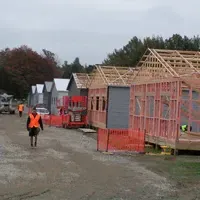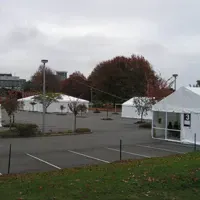Groundhog Day in Christchurch
Written by

By Kip Brook
They talk about the recovery and the rebuild. There is no talk of patching up Christchurch, post February 22’s earthquake. But it’s happening.
Christchurch is a long way off the permanent rebuild. So much is being patched up, propped up and covered up, for the time being. On the Canterbury University carpark, students and staff cars have been replaced by ‘tent city’ – for lectures in tents. Across campus the Oval Village is taking shape, with 57 lecture buildings being built in record time as winter advances. Another 47 buildings will pop up on the northern side. These are expected to be around 5-10 years.
In town by the CBD, a row of tents are pegged down on the hallowed Christ’s College grassed quadrangle – more temporary classrooms. It’s a similar sight in other schools putting up prefabs to cope. Like most prefabs, are they temporary? There’s no choice but to patch up and cope as best as possible, for quite some time. It’s reality.
Emergency workers, Civil Defence and so many assisting are doing an incredible job in terrible circumstances. Demolition and deconstruction teams have not begun the pulling down of the Heritage hotel, the tilting Grand Chancellor or the Copthorne on Durham St, though many other iconic buildings have been torn down leaving empty sites across the city.
The deconstruction of the landmark Strategy building on the corner of Salisbury St has closed the busy Montreal St two-way system, which has impacted on traffic and impinged on some businesses that have re-opened.
As Civil Defence controller John Hamilton says, two steps forward one step back. For the rest of the world, the February 22 earthquake has become old news. It was an event two months ago and there may be an impression that Christchurch has settled back down, rebuilding and on the mend. Not so.
A 5.3 after-shock last weekend that caused the weakened Strategy to lean dangerously, resulted in 150 new rock-falls, more liquefaction, 20,000 homes without power for hours, burst 29 water pipes and people’s nerves being tested again was a timely reminder that Christchurch is not out of danger yet.
Health authorities are concerned some homes will be colder this winter because of earthquake damage and some people are living in crowded houses, increasing the impact of flu and increasing chances of developing complications. Some people are feeling run down or have become stressed which makes them more prone to getting viruses like the flu. Damage from the September 4 and February 22 earthquakes has changed a lot of Cantabrians living conditions.
In parts of the city, sewerage pipes have broken or are breaking as services come back online.
The Avon River today carries untreated sewage. People are sleeping poorly, or are irritable, nervous, feeling tired and experiencing a multitude of emotions such as anger, guilt or sadness. The City Mission has an unprecedented demand for food parcels out east with a 100 percent increase in food parcels being given out.
For others, it’s like Groundhog Day in Christchurch. Each day they drive through pockets of the city which look just as they did moments after 12.51pm on February 22 when the fatal earthquake that killed 181 people altered lives for all of us in Christchurch forever. The city that we knew and is no longer. It is still under a state of national emergency.
The earthquakes have irrevocably scarred this most-English of all New Zealand cities. The trams have stopped and the Cathedral Square, the heart soul of this garden city, is cordoned off and under curfew like much of the CBD. AMI Stadium, is so bad the Crusaders rugby team will not play there this year. When it reopens, it must be renamed AMI Lancaster Park. The Ellerslie Flower Show on Hagley Park never happened this year. Christchurch took the ‘hit’ for Wellington which had been tipped as the most at risk city to suffer a big earthquake.
Meanwhile, winter is closing in and rain this week has caused flooding out east. The red zones in Christchurch’s central business district are under a 7am to 7pm curfew.
A popular central Christchurch shopping hub Cashel Mall and part of the popular Oxford Tce hospitality area will not reopen until the end of October, eight months after the earthquake.
At Burnside High, they are preparing for a May 5-7 Repertory Theatre production of Hamlet, directed by Robert Gilbert. Robert is now also playing the role of and Laertes, which was to have been played by his son Jaime Robert McDowell Gilbert, but he was one of February 22’s victims. A trust has been set up for Jaime’s children.
"When Jaime died, my heart utterly broke. I have never known such deep pain. Even now, it’s unbearable to be thinking of his passing. I’m better off to keep busy. Hamlet will keep me busy for a while," Robert Gilbert said today.
